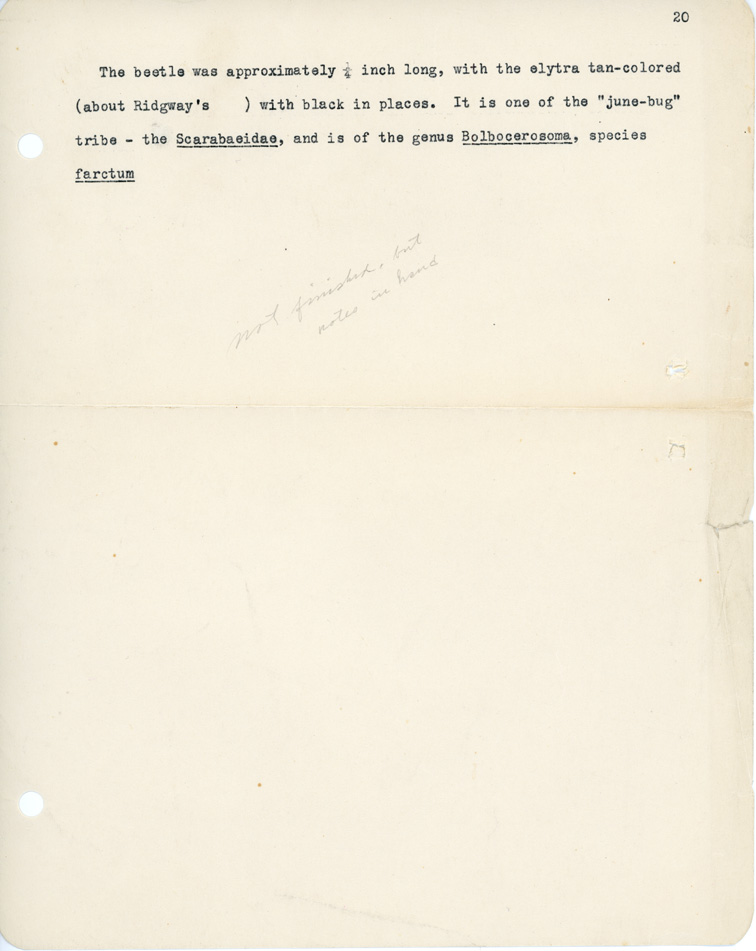Great Nebraska
Naturalists and Scientists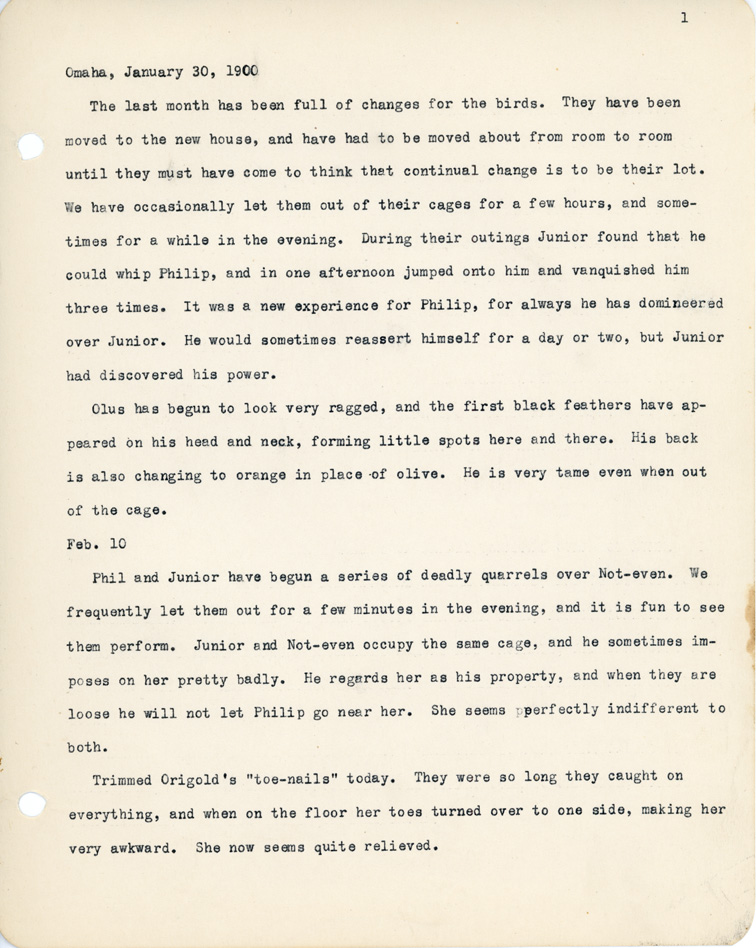
Omaha, January 30, 1900
The last month has been full of changes for the birds. They have been moved to the new house, and have had to be moved about from room to room until they must have come to think that continual changes is to be their lot. We have occasionally let them out of their cages for a few hours, and sometimes for a while in the evening. During their outings Junior found that he could whip Philip, and in one afternoon jumped onto him and vanquished him three times. It was a new experience for Philip, for always he has domineered over Junior. He would sometimes reassert himself for a day or two, but Junior had discovered his power.
Olus has begun to look very ragged, and the first black feathers have appeared on his head and neck, forming little spots here and there. His back is also changing to orange in place of olive. He is very tame even when out of the cage.
Feb. 10
Phil and Junior have begun a series of deadly quarrels over Not-even. We frequently let them out for a few minutes in the evening, and it is fun to see them perform. Junior and Not-even occupy the same cage, and he sometimes imposes on her pretty badly. He regards her as his property, and when they are loose he will not let Philip go near her. She seems perfectly indifferent to both.
Trimmed Origold’s “toe-nails” today. They were so long they caught on everything, and when on the floor her toes turned over to one side, making her very awkward. She now seems quite relieved.
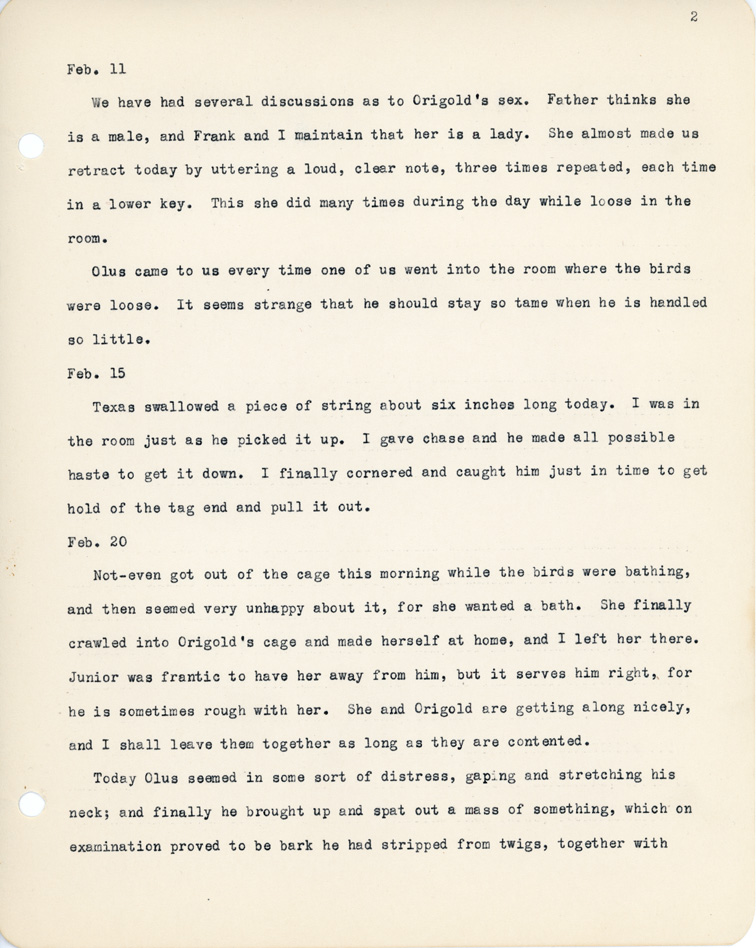
Feb. 11
We have had several discussions as to Origold’s sex. Father thinks she is male, and Frank and I maintain that her is a lady. She almost made us retract today by uttering a loud, clear note, three times repeated, each time in a lower key. This she did many times during the day while loose in the room.
Olus came to us every time one of us went into the room where the birds were loose. It seems strange that he should stay so tame when he is handled so little.
Feb. 15
Texas swallowed a piece of string about six inches long today. I was in the room just as he picked it up. I gave chase and he made all possible haste to get it down. I finally cornered and caught him just in time to get hold of the tag end and pull it out.
Feb. 20
Not-even got out of the cage this morning while the birds were bathing, and then seemed very unhappy about it, for she wanted a bath. She finally crawled into Origold’s cage and made herself at home, and I left her there. Junior was frantic to have her away from him, but it serves him right, for he is sometimes rough with her. She and Origold are getting along nicely, and I shall leave them together as long as they are contented.
Today Olus seemed in some sort of distress, gaping and stretching his neck; and finally he brought up and spat out a mass of something, which on examination proved to be bark he had stripped from twigs, together with
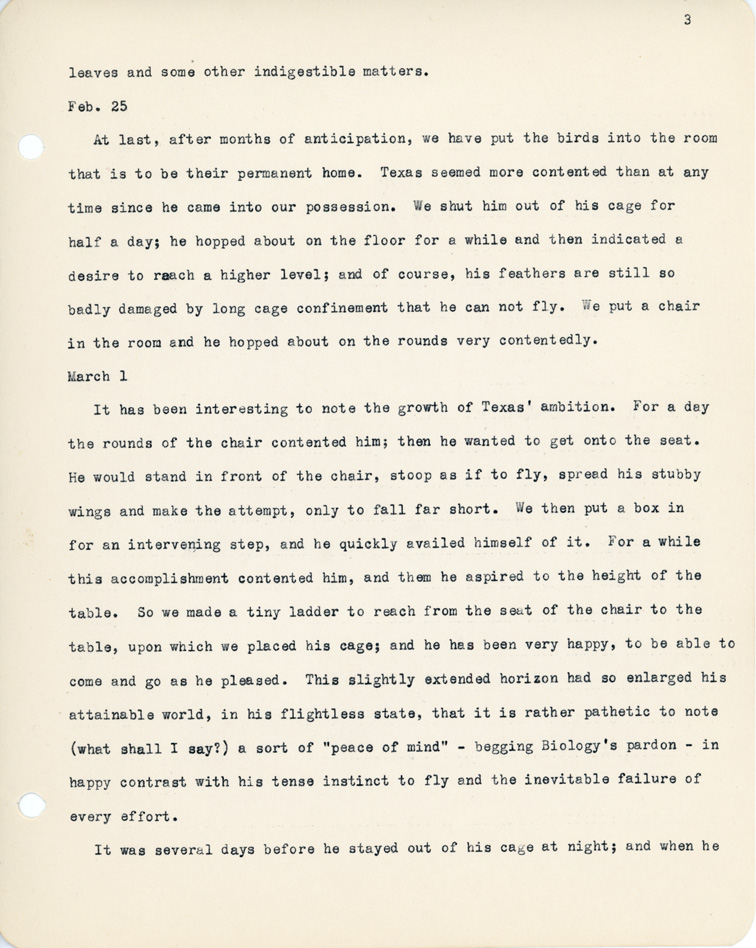
leaves and some other indigestible matters.
Feb. 25
At last, after months of anticipation, we have put the birds into the that is to be their permanent home. Texas seemed more contented than at any time since he came into our possession. We shut him out of his cage for half a day; he hopped about on the floor for a while and then indicated a desire to reach a higher level; and of course, his feathers are still so badly damaged by long cage confinement that he can not fly. We put a chair in the room and he hopped about on the rounds very contentedly.
March 1
It has been interesting to note the growth of Texas’ ambition. For a day the rounds of the chair contented him; then he wanted to get onto the seat. He would stand in front of the chair, stoop as if to fly spread his stubby wings and make the attempt, only to fall far short. We then put a box in for an intervening step, and he quickly availed himself of it. For a while this accomplishment contented him, and them he aspired to the height of the table. So we made a tiny ladder to reach from the seat of the chair to the table, upon which we placed his cage; and he has been very happy, to be able come and go as he pleased. This slightly extended horizon had so enlarged his attainable world, in his flightless state, that it is rather pathetic to note (what shall I say?) a sort of “peace of mind” – begging Biology’s pardon – in happy contrast with his tense instinct to fly and the inevitable failure of every effort.
It was several days before he stayed out of his cage at night; and when he
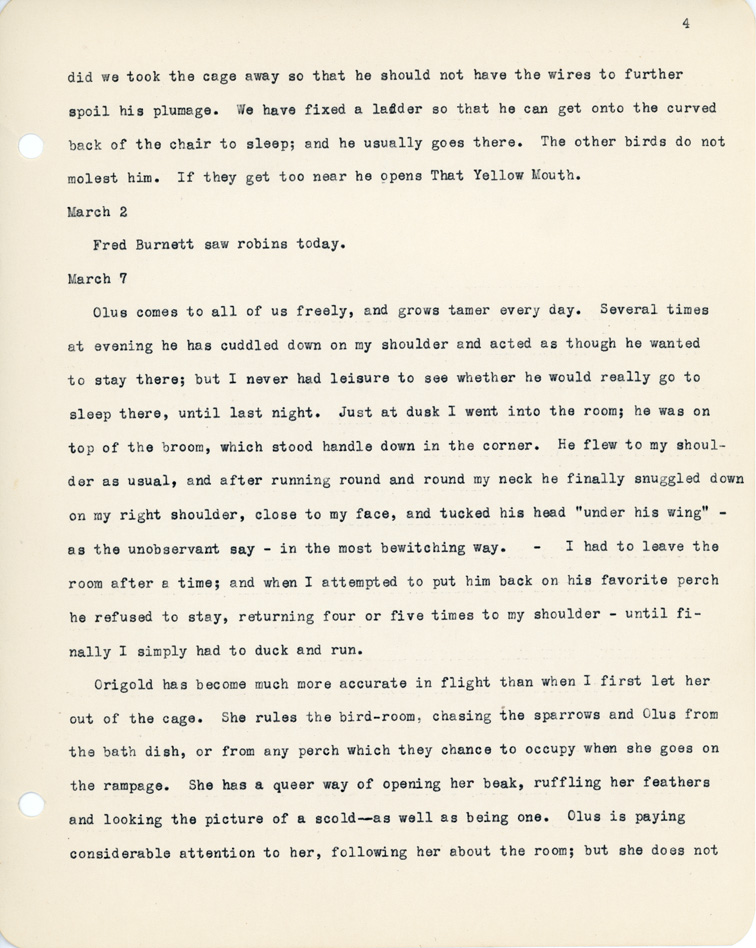
did we took the cage away so that he should not have the wires to further spoil his plumage. We have fixed a ladder so that he can get onto the curved back of the chair to sleep; and he usually goes there. The other birds do not molest him. If they get too near he open That Yellow Mouth.
March 2
Fred Burnett saw robins today.
March 7
Olus comes to all of us freely, and grows tamer every day. Several times at evening he has cuddled down on my shoulder and acted as though he wanted to stay there; but I never had leisure to see whether he would really go to sleep there, until last night. Just at dusk I went into the room; he was on top of the broom, which stood handle down in the corner. He flew to my shoulder as usual, and after running round and round my neck he finally snuggled down on my right shoulder close to my face, and tucked his head “under his wing” – as the unobservant say – in the most bewitching way. – I had to leave the room after a time; and when I attempted to put him back on his favorite perch he refused to stay, returning four or five times to my shoulders – until finally I simply had to duck and run.
Origold has become much more accurate in flight than when I first let her out of the cage. She rules the bird-room, chasing the sparrows and Olus from the bath dish, or from any perch which they chance to occupy when she goes on the rampage. She has a queer way of opening her beak, ruffling her feathers and looking the picture of a scold—as well as being one. Olus is paying considerable attention to her, following her about the room; but she does not
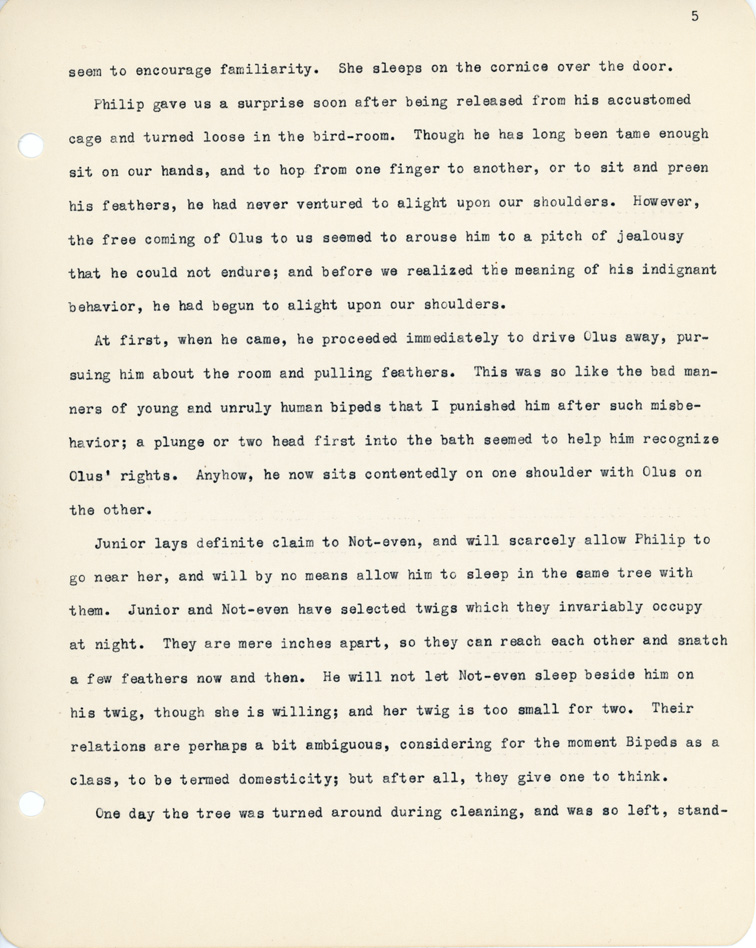
seem to encourage familiarity. She sleeps on the cornice over the door.
Philip gave us a surprise soon after being released from his accustomed cage and turned loose in the bird-room. Though he has long been tame enough sit on our hands, and to hop from one finger to another, or to sit and preen his feathers, he had never ventured to alight upon our shoulders. However, the free coming of Olus to us seemed to arouse him to a pitch of jealousy that he could not endure; and before we realized the meaning of his indignant behavior, he had begun to alight upon our shoulders.
At first, when he came, he proceeded immediately to drive Olus away, pursuing him about the room and pulling feathers. This was so like the bad manners of young and unruly human bipeds that I punished him after such misbehavior; a plunge or two head first into the bath seemed to help him recognize Olus’ rights. Anyhow, he now sits contentedly on one shoulder with Olus on the other.
Junior lays definite claim to Not-even, and will scarcely allow Philip to go near her, and will by no means allow him to sleep in the same tree with them. Junior and Not-even have selected twigs which they invariably occupy at night. They are mere inches apart, so they can reach each other and snatch a few feathers now and then. He will not let Not-even sleep beside him on his twig, though she is willing; and her twig is too small for two. Their relations are perhaps a bit ambiguous, considering for the moment Bipeds as a class, to be termed domesticity; but after all, they give one to think.
One day the tree was turned during cleaning, and was so left, stand-
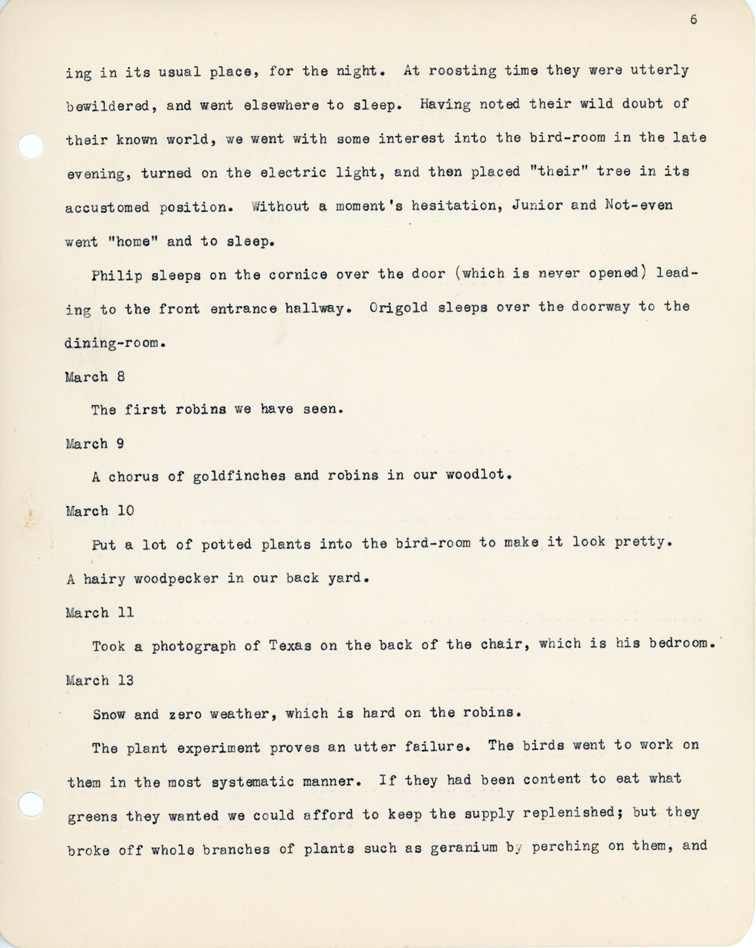
ing in its usual place, for the night. At roosting time they were utterly bewildered, and went elsewhere to sleep. Having noted their wild doubt of their known world, we went with some interest into the bird-room in the late evening, turned on the electric light, and then placed “their” tree in its accustomed position. Without a moment’s hesitation, Junior and Not-even went “home” and to sleep.
Philip sleeps on the cornice over the door (which is never opened) leading to the front entrance hallway. Origold sleeps over the doorway to the dining-room.
March 8
The first robins we have seen.
March 9
A chorus of goldfinches and robins in our woodlot.
March 10
Put a lot of potted plants into the bird-room to make it look pretty. A hairy woodpecker in our back yard.
March 11
Took a photograph of Texas on the back of the chair, which is his bedroom.
March 13
Snow and zero weather, which is hard on the robins.
The plant experiment proves an utter failure. The birds went to work on them in the most systematic manner. If they had been content to eat what greens they wanted we could afford to keep the supply replenished; but they broke off while branches of plants such as geranium by perching by perching on them, and
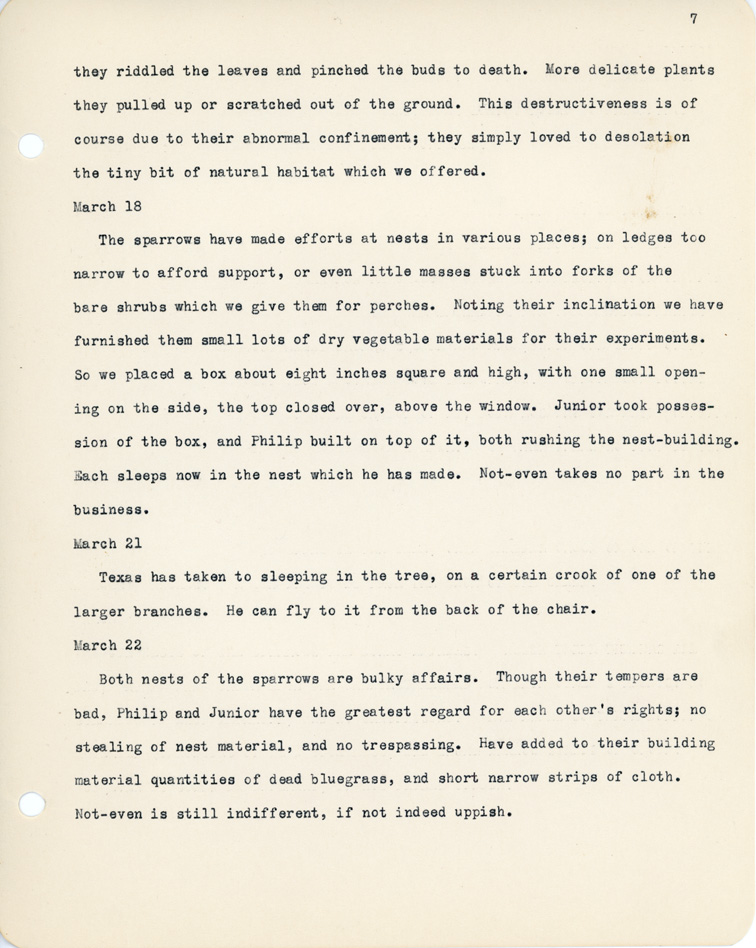
they riddled the leaves and pinched the buds to death. More delicate plants they pulled up or scratched out of the ground. This destructiveness is of course due to their abnormal confinement; they simply loved to desolation the tiny bit of natural habitat which we offered.
March 18
The sparrows have made efforts at nests in various places; on ledges too narrow to afford support, or even little masses stuck into forks of the bare shrubs which we give them for perches. Noting their inclination we have furnished them small lots of dry vegetable materials for their experiments. So we placed a box about eight inches square and high, with one small opening on the side, the top closed over, above the window. Junior took possession of the box, and Philip built on top of it, both rushing the nest-building. Each sleeps now in the nest which he has made. Not-even takes no part in the business.
March 21
Texas has taken to sleeping in the tree, on a certain crook of one of the larger branches. He can fly to it from the back of the chair.
March 22
Both nests of the sparrows are bulky affairs. Though their tempers are bad, Philip and Junior have the greatest regard for each other’s rights; no stealing of nest material, and no trespassing. Have added to their building material quantities of dead bluegrass, and short narrow strips of cloth. Not-even is still indifferent, if not indeed uppish.
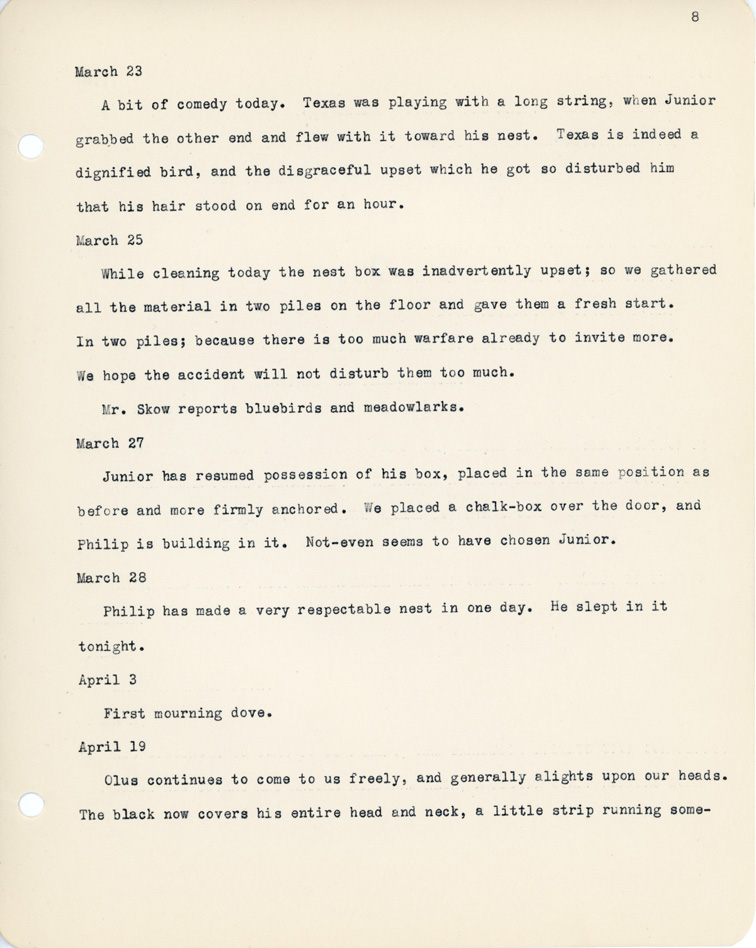
March 23
A bit of comedy today. Texas was playing with a long string, when Junior grabbed the other end and flew with it toward his nest. Texas is indeed a dignified bird, and the disgraceful upset which he got so disturbed him that his hair stood on end for an hour.
March 25
While cleaning today the nest box was inadvertently upset; so we gathered all the material in tow piles on the floor and gave them a fresh start. In two piles; because there is too much warfare already to invite more. We hope the accident will not disturb them too much.
Mr. Skow reports bluebirds and meadowlarks.
March 27
Junior has resumed possession of his box, placed in the same position as before and more firmly anchored. We placed a chalk-box over the door, and Philip is building in it. Not-even seems to have chosen Junior.
March 28
Philip has made a very respectable nest in one day. He slept in it tonight.
April 3
First mourning dove.
April 19
Olus continues to come to us freely, and generally alights upon our heads. The black now covers his entire head and neck, a little strips running some-
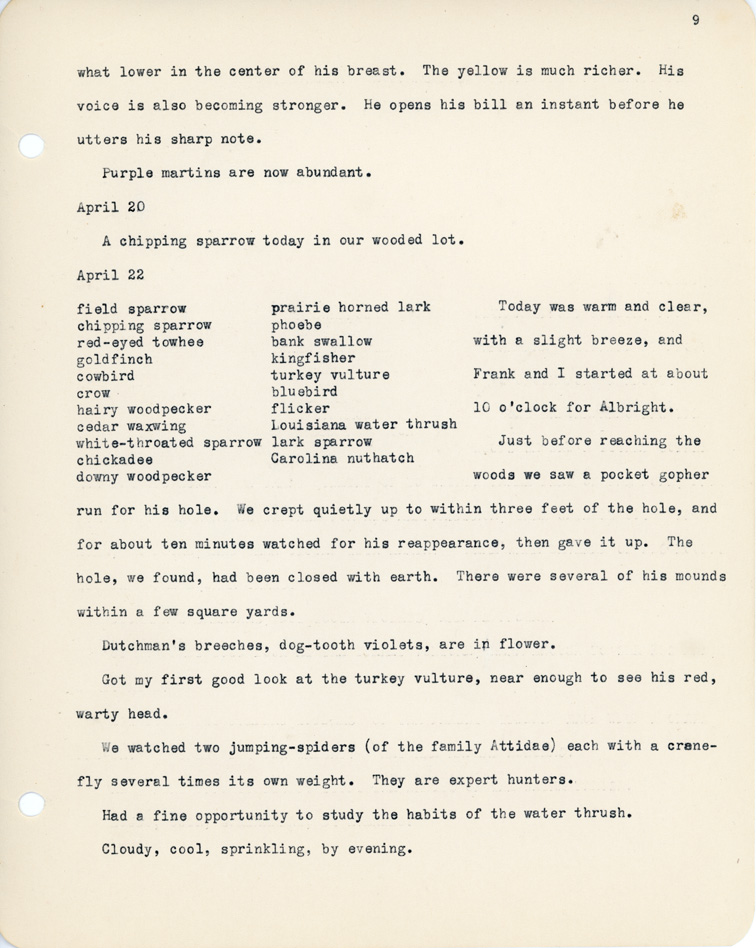
what lower in the center of his breast. The yellow is much richer. His voice is also becoming stronger. He opens his bill an instant before he utters his sharp note.
Purple martins are now abundant.
April 20
A chipping sparrow today in our wooded lot.
April 22
field sparrow prairie horned lark
chipping sparrow phoebe
red-eyed towhee bank swallow
goldfinch kingfisher
cowbird turkey vulture
crow bluebird
hairy woodpecker flicker
cedar waxwing Louisiana water thrush
white-throated sparrow lark sparrow
chickadee Carolina nuthatch
downy woodpecker
Today was warm and clear, with a slight breeze, and Frank and I started at about 10 o’clock for Albright.
Just before reaching the woods we saw a pocket gopher run for his hole. We crept quietly to within three feet of the hole, and for about ten minutes watched for his reappearance, the gave it up. The hole, we found had been closed with earth. There were several of his mounds within a few square yards.
Dutchman’s breeches, dog-tooth violets, are in flower.
Got my first good look at the turkey vulture, near enough to see his red warty head.
We watched two jumping-spiders (of the family Attidae) each with a cranefly several times its own weight. They are expert hunters.
Had a fine opportunity to study the habits of the water thrush.
Cloudy, cool, sprinkling, by evening.
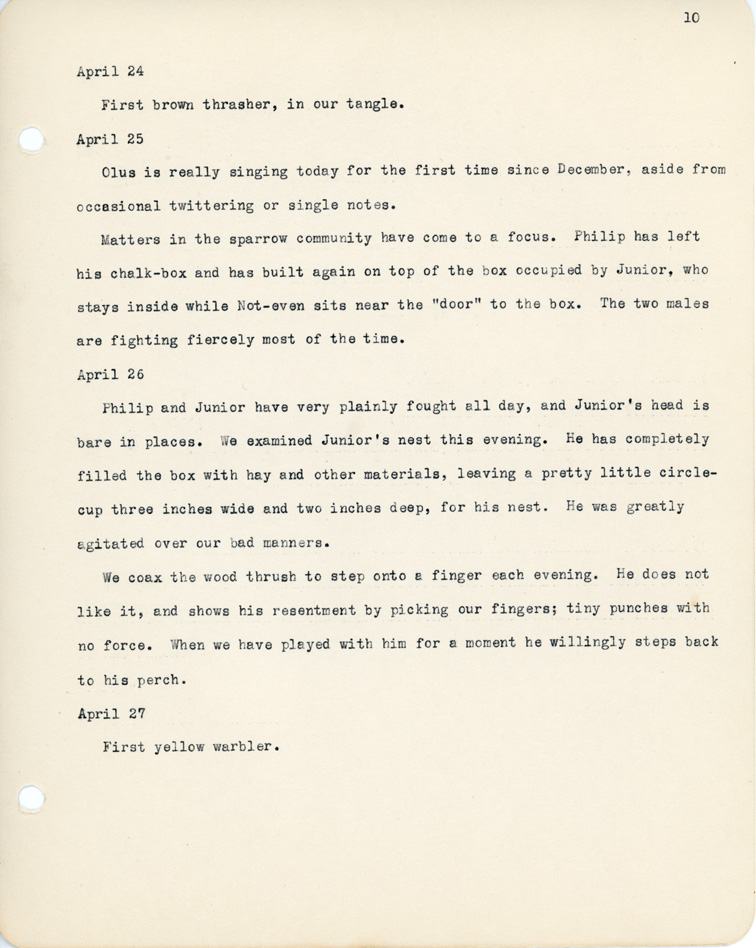
April 24
First brown thrasher, in our tangle.
April 25
Olus is really singing today for the first time since December, aside from occasional twittering or single notes.
Matters in the sparrow community have come to a focus. Philip has left his chalk-box and has built again on top of the box occupied by Junior, who stays inside while Not-even sits near the “door” of the box. The two males are fighting fiercely most of the time.
April 26
Philip and Junior have very plainly fought all day, and Junior’s head is bare in places. We Examined Junior’s nest this evening. He has completely filled the box with hay and other materials, leaving a pretty little circle-cup three inches wide and two inches deep, for his nest. He was greatly agitated over our bad manners.
We coax the wood thrush to step onto a finger each evening. He does not like it, and shows his resentment by picking our fingers; tiny punches with no force. When we have played with him for a moment he willingly steps back to his perch.
April 27
First yellow warbler.
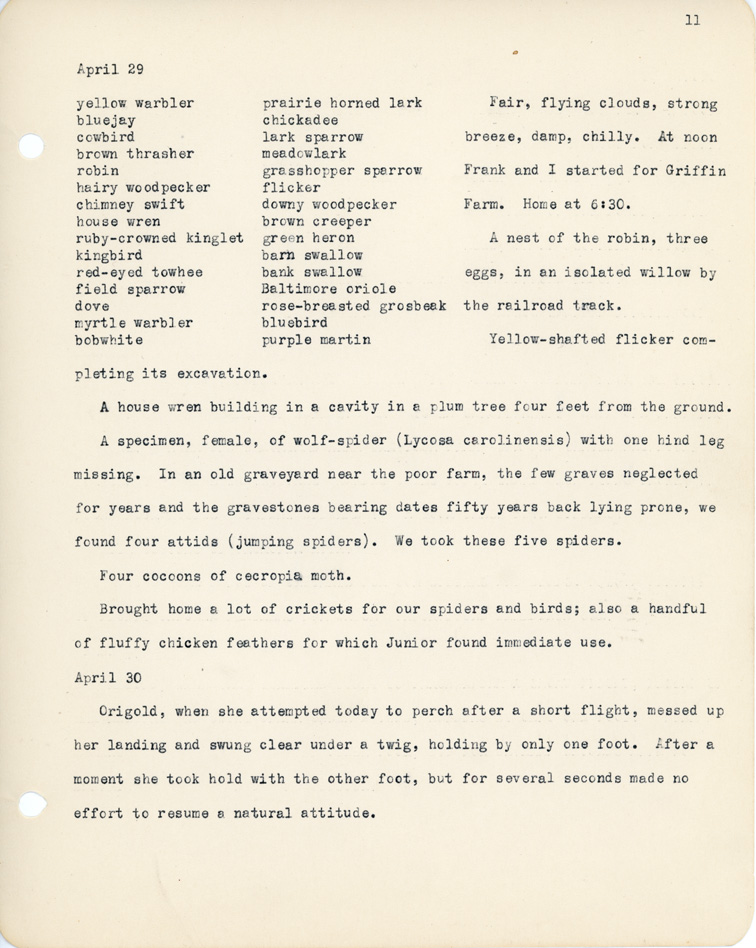
April 29
yellow warbler prairie horned lark
bluejay chickadee
cowbird lark sparrow
brown thrasher meadowlark
robin grasshopper sparrow
hairy woodpecker flicker
chimney swift downy woodpecker
House wren brown creeper
ruby-crowned kinglet green heron
kingbird barn swallow
red-eyed towhee bank swallow
field sparrow Baltimore oriole
dove rose-breasted grosbeak
myrtle warbler bluebird
bobwhite purple martin
Fair, flying clouds, strong breeze, damp, chilly. At noon Frank and I started for Griffin Farm. Home at 6:30.
A nest of the robin, three eggs, in an isolated willow by the railroad track.
Yellow-shafted flicker completing its excavation.
A house wren building in a cavity in a plum tree four feet from the ground.
A specimen, female, of wolf-spider (Lycosa carolinensis) with one hind leg missing. In an old graveyard near the poor farms, the few graves neglected for years and the gravestones bearing dates fifty years back lying prone, we found four attids (jumping spiders). We took these five spiders.
Four cocoons of cecropia moth.
Brought home a lot of crickets for our spiders and birds; also a handful of fluffy chicken feathers for which Junior found immediate use.
April 30
Origold, when she attempted today to perch after a short flight, messed up her landing and swung clear under a twig, holding by only one foot. After a moment she took hold with the other foot, but for several seconds made no effort to resume a natural attitude.
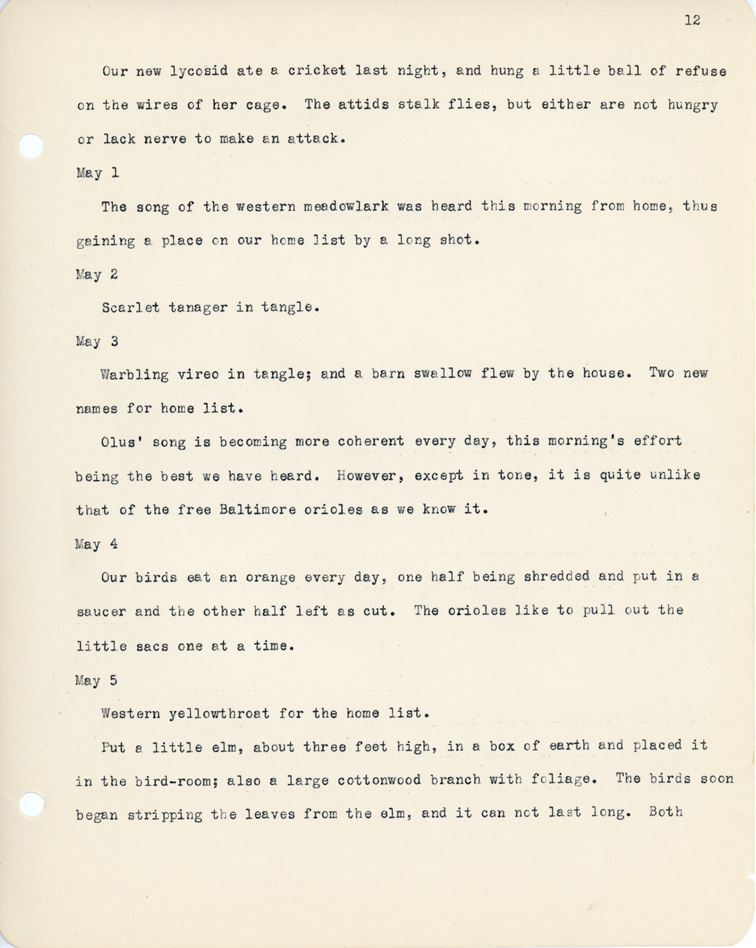
Our new lycosid ate a cricket last night, and hung a little ball of refuse on the wires of her cage. The attids stalk flies, but either are not hungry or lack nerve to make an attack.
May 1
The song of the western meadowlark was heard this morning from home, thus gaining a place on our home list by a long shot.
May 2
Scarlet tanager in tangle.
May 3
Warbling vireo in tangle; and a barn swallow flew by the house. Two new names for home list.
Olus’ song is becoming more coherent every day, this morning’s effort being the best we have heard. However, except in tone, it is quite unlike that of the free Baltimore orioles as we know it.
May 4
Our birds eat an orange every day, one half being shredded and put in a saucer and the other half left as cut. The orioles like to pull out the little sacs one at a time.
May 5
Western yellowthroat for the home list.
Put a little elm, about three feet high, in a box of earth and placed it in the bird-room; also a large cottonwood branch with foliage. The birds soon began stripping the leaves from the elm, and it can not last long. Both
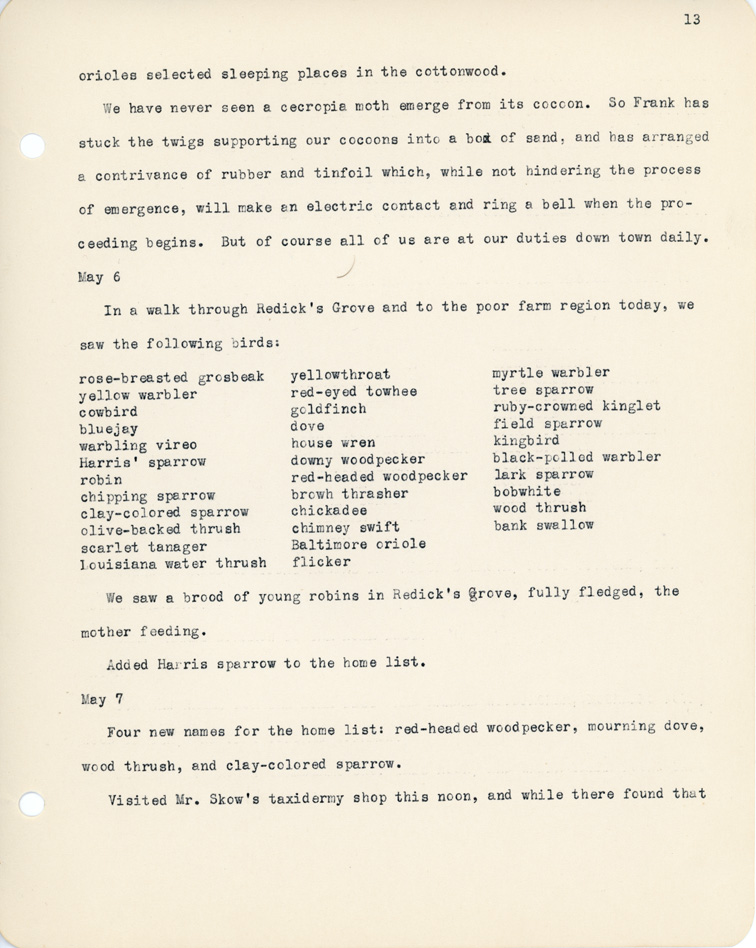
orioles selected sleeping places in the cottonwood.
We have never seen a cecropia moth emerge from its cocoon. So Frank has stuck the twigs supporting our cocoons into box of sand, and has arranged a contrivance of rubber and tinfoil which, while not hindering the process of emergence, will make an electric contact and ring a bell when the proceeding begins. But of course all of us are at our duties down town daily.
May 6
In a walk through Redick’s Grove and to the poor farm region today, we saw the following birds:
rose-breasted grosbeak yellowthroat myrtle warbler
yellow warbler red-eyed towhee tree sparrow
cowbird goldfinch ruby-crowned kinglet
bluejay dove field sparrow
warbling vireo house wren kingbird
Harris’ sparrow downy woodpecker lark sparrow
chipping sparrow browh [sic] thrasher bobwhite
clay-colored sparrow chickadee wood thrush
olive-backed thrush chimney swift bank swallow
Louisiana water thrush flicker
We saw a brood of young robins in Redick’s Grove, fully fledged, the mother feeding.
Added Harris sparrow to the home list.
May 7
Four new names for the home list: red-headed woodpecker, mourning dove, wood thrush, and clay-colored sparrow
Visited Mr. Skow’s taxidermy shop this noon, and while there found that
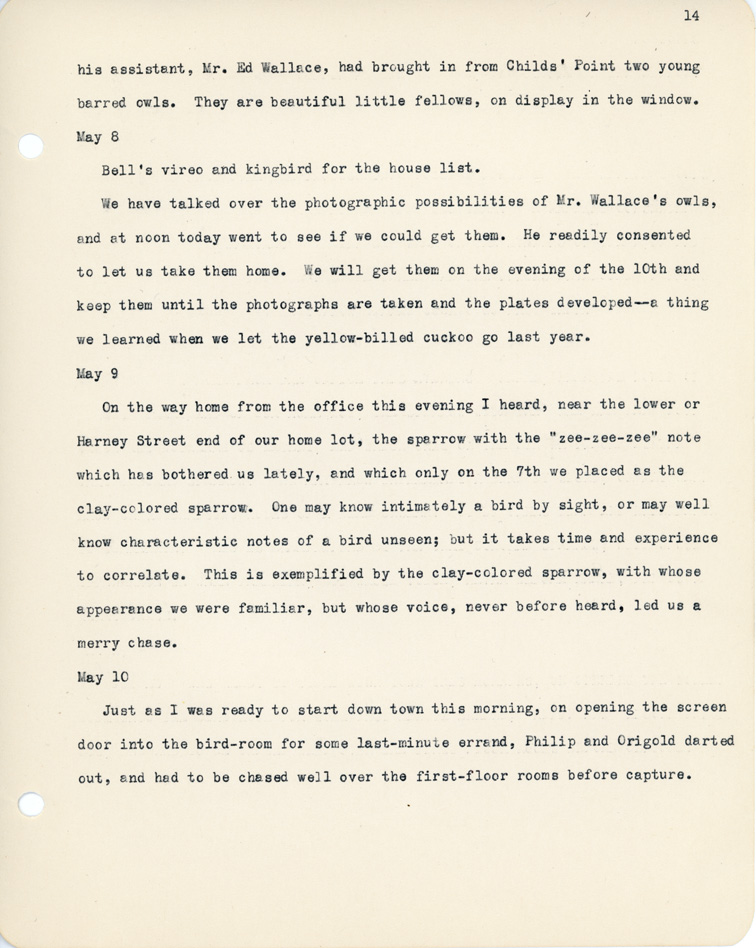
his assistant, Mr. Ed Wallace, had brought in from Childs’ Point two young barred owls. They are beautiful little fellows, on display in the window.
May 8
Bell’s vireo and kingbird for the house list.
We have talked over the photographic possibilities of Mr. Wallace’s owls, and at noon today went to see if we could get them. He readily consented to let us take them home. We will get them on the evening of the 10th and keep them until the photographs are taken and the plates developed—a thing we learned when we let the yellow-billed cuckoo go last year.
May 9
On the way home from the office this evening I heard, near the lower or Harney Street end of our home lot, the sparrow with the “zee-zee-zee” note which has bothered us lately, and which only on the 7th we placed as the clay-colored sparrow. One may know intimately a bird by sight, or may well know characteristic notes of a bird unseen; but it takes time and experience to correlate. This is exemplified by the clay-colored sparrow, with whose appearance we were familiar, but whose voice, never before heard, led us a merry chase.
May 10
Just as I was ready to start down town this morning, on opening the screen door into the bird-room for some last-minute errand, Philip and Origold darted out, and had to be chased well over the first-floor rooms before capture.
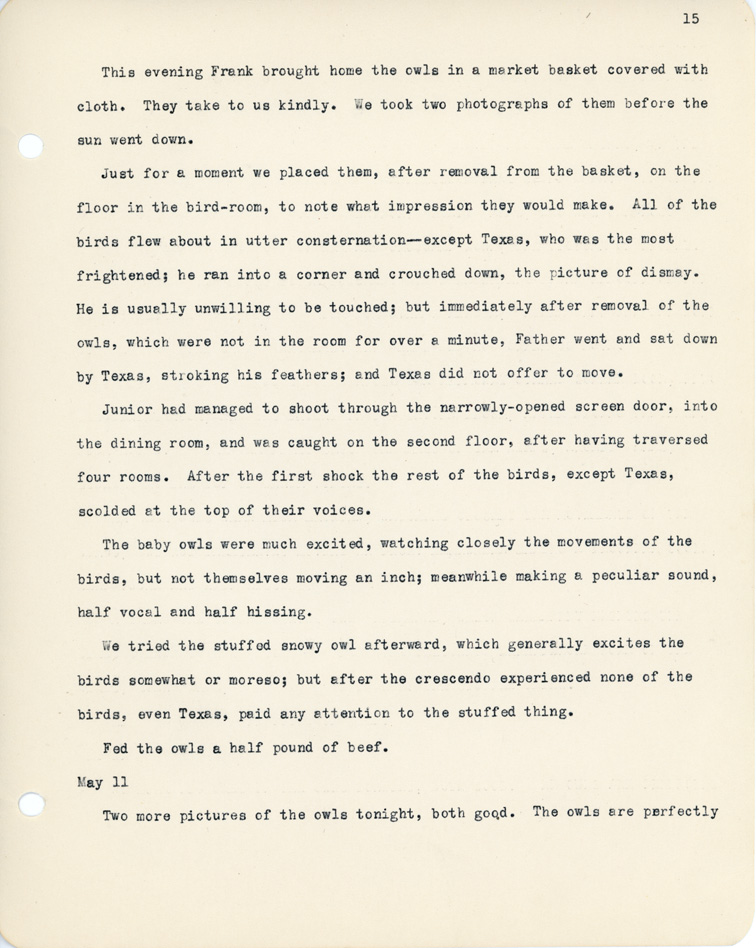
This evening Frank brought home the owls in a market basket covered with cloth. They take to us kindly. We took two photographs of them before the sun went down.
Just for a moment we placed them, after removal from the basket, on the floor in the bird-room, to note what impression they would make. All of the birds flew about in utter consternation—except Texas, who was the most frightened; he ran into a corner and crouched down, the picture of dismay. He is usually unwilling to be touched; but immediately after removal of the owls, which were not in the room for over a minute, Father went and sat down by Texas, stroking his feathers; and Texas did not offer to move.
Junior had managed to shoot through the narrowly-opened screen door, into the dining room, and was caught on the second floor, after having traversed four rooms. After the first shock the rest of the birds, except Texas, scolded at the top of their voices.
The baby owls were much excited, watching closely the movements of the birds, but not themselves moving an inch; meanwhile making a peculiar sound, half vocal and half hissing.
We tried the stuffed snowy owl afterward, which generally excites the birds somehwat or moreso; but after the crescendo experienced none of the birds, even Texas, paid any attention to the stuffed thing.
Fed the owls a half pound of beef.
May 11
Two more pictures of the owls tonight, both good. The owls are perfectly
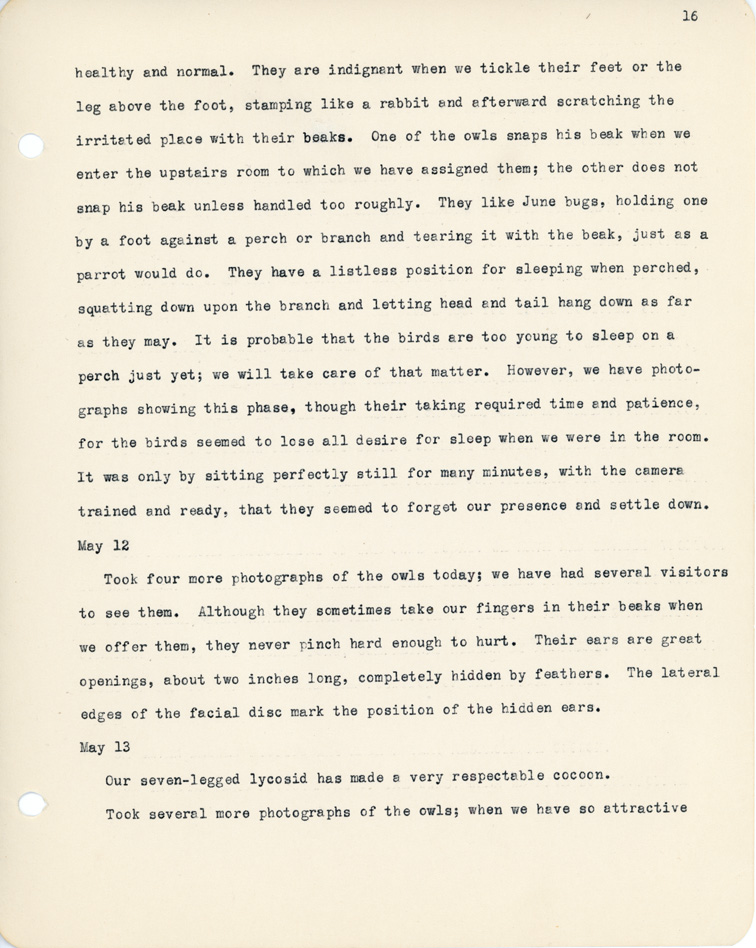
healthy and normal. They are indignant when we tickle their feet or the leg above the foot, stamping like a rabbit and afterward scratching the irritated place with their beaks. One of the owls snaps his beak when we enter the upstairs room to which we have assigned them; the other does not snap his beak unless handled too roughly. They like June bugs, holding one by a foot against a perch or branch and tearing it with the beak, just as a parrot would do. They have a listless position for sleeping when perched, squatting down upon the branch and letting head and tail hang down as far as they may. It is probable that the birds are too young to sleep on a perch just yet; we will take care of that matter. However, we have photographs showing this phase, though their taking required time and patience, for the birds seemed to lose all desire for sleep when we were in the room. It was only by sitting perfectly still for many minutes, with the camera trained and ready, that they seemed to forget our presence and settle down.
May 12
Took four more photographs of the owls today; we have had several visitors to see them. Although they sometimes take our fingers in their beaks when we offer them, they never pinch hard enough to hurt. Their ears are great openings, about two inches long, completely hidden by feathers. The lateral edges of the facial disc mark the position of the hidden ears.
May 13
Our seven-legged lycosid has made a very respectable cocoon.
Took several more photographs of the owls; when we have so attractive
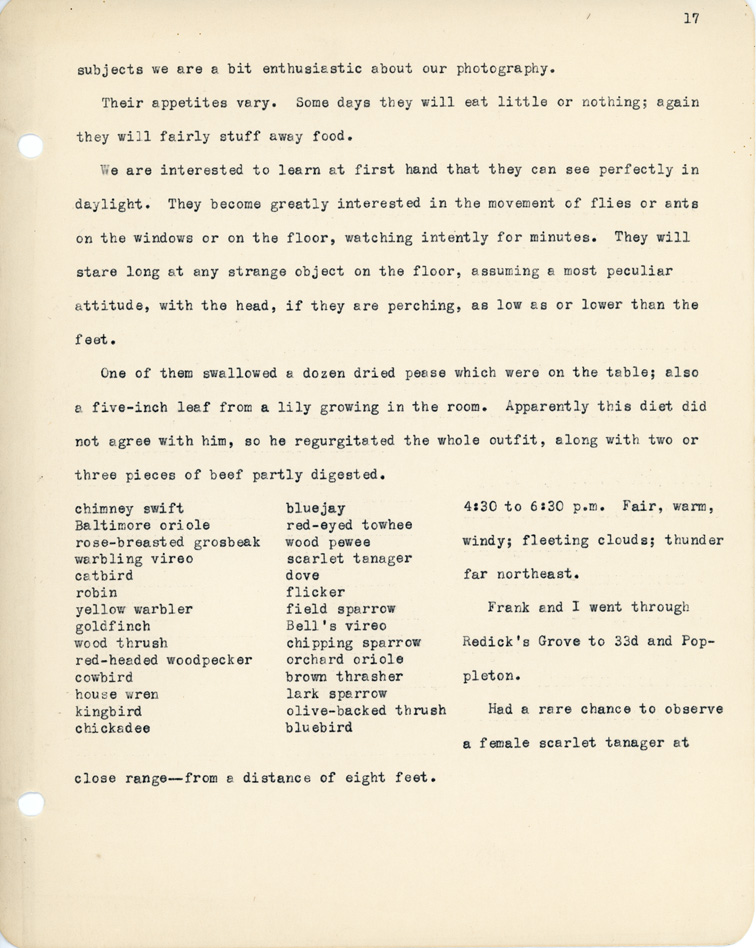
subjects we are a bit enthusiastic about our photography.
Their appetites vary. Some days they will eat little or nothing; again they will fairly stuff away food.
We are interested to learn at first hand that they can see perfectly in daylight. They become greatly interested in the movement of flies or ants on the windows or on the floor, watching intently for minutes. They will stare long at any strange object on the floor, assuming a most peculiar attitude, with the head, if they are perching, as low as or lower than the feet.
One of them swallowed a dozen dried pease [sic] which were on the table; also a five-inch leaf from a lily growing in the room. Apparently this diet did not agree with him, so he regurgitated the whole outfit, along with two or three pieces of beef partly digested.
chimney swift bluejay
Baltimore oriole red-eyed towhee
rose-breasted grosbeak wood pewee
warbling vireo scarlet tanager
catbird dove
robin flicker
yellow warbler field sparrow
goldfinch Bell’s vireo
wood thrush chipping sparrow
red-headed woodpecker orchard oriole
cowbird brown thrasher
house wren lark sparrow
kingbird olive-backed thrush
chickadee bluebird
4:30 to 6:30 p.m. Fair, warm, windy; fleeting clouds; thunder far northeast.
Frank and I went through Redick’s Grove to 33d [sic] and Poppleton.
Had a rare chance to observe a female scarlet tanager at close range—from a distance of eight feet.
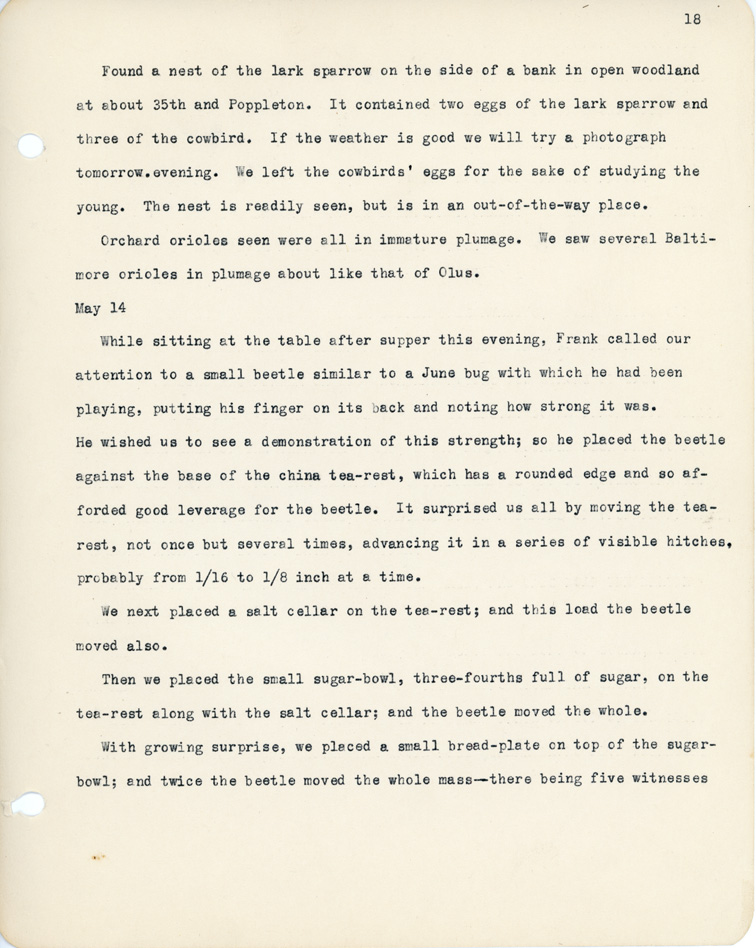
Found a nest of the lark sparrow on the side of a bank in open woodland at about 35th and Poppleton. It contained two eggs of the lark sparrow and three of the cowbird. If the weather is good we will try a photograph tomorrow.evening [sic] We left the cowbirds’ eggs for the sake of studying the young. The nest is readily seen, but is in an out-of-the-way place.
Orchard orioles seen were all in immature plumage. We saw several Baltimore orioles in plumage about like that of Olus.
May 14
While sitting at the table after supper this evening, Frank called our attention to a small beetle similar to a June bug with which he had been playing, putting his finger on its back and noting how strong it was. He wished us to see a demonstration of this strength; so he placed the beetle against the base of the china tea-rest, which has a rounded edge and so afforded good leverage for the beetle. It surprised us all by moving the tea-rest, not once but several times, advancing it in a series of visible hitches, probably from 1/16 to 1/8 inch at a time.
We next placed a salt cellar on the tea-rest; and this load the beetle moved also.
Then we placed the small sugar-bowl, three-fourths full of sugar, on the tea-rest along with the salt cellar; and the beetle moved the whole.
With growing surprise, we placed a small bread-plate on top of the sugar-bowl; and twice the beetle moved the whole mass—there being five witnesses
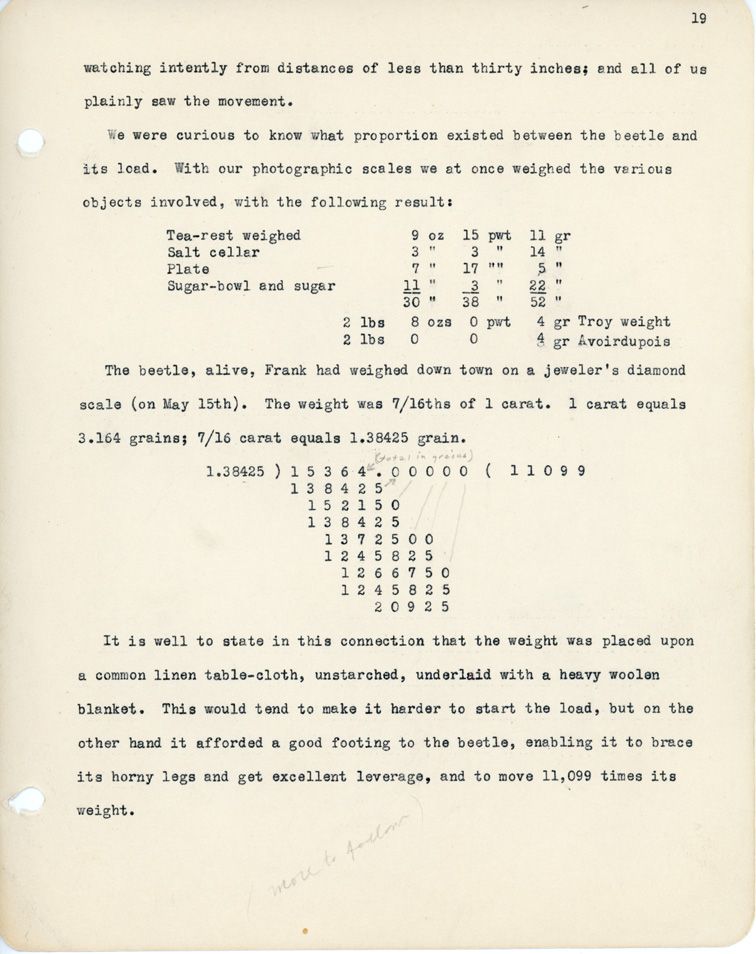
watching intently from distances of less than thirty inches; and all of us plainly saw the movement.
We were curious to know what proportion existed between the beetle and its load. With our photographic scales we at once weighed the various objects involved, with the following result:
Tea-rest weighed 9oz 15pwt 11gr
Salt cellar 3“ 3“ 14“
Plate 7“ 17“ 5“
Sugar-bowl and sugar 11“ 3″ 22“
30“ 38“ 52“
2lbs 8ozs 0pwt 4gr Troy weight
2lbs 0 0 4gr Avoirdupois
The beetle, alive, Frank had weighed down town on a jeweler’s diamond scale (on May 15th). The weight was 7/16ths of 1 carat. 1 carat equals 3.164 grains; 7/16 carat equals 1.38425 grain.
1.38425 ) 1 5 3 6 4 . 0 0 0 0 0 ( 1 1 0 9 9
1 3 8 4 2 5
1 5 2 1 5 0
1 3 8 4 2 5
1 3 7 2 5 0 0
1 2 4 5 8 2 5
1 2 6 6 7 5 0
1 2 4 5 8 2 5
2 0 9 2 5
It is well to state in this connection that the weight was placed upon a common linen table-cloth, unstarched, underlaid with a heavy woolen blanket. This would tend to make it harder to start the load, but on the other hand it afforded a good footing to the beetle, enabling it to brace its horny legs and gets excellent leverage, and to move 11,099 times its weight.
